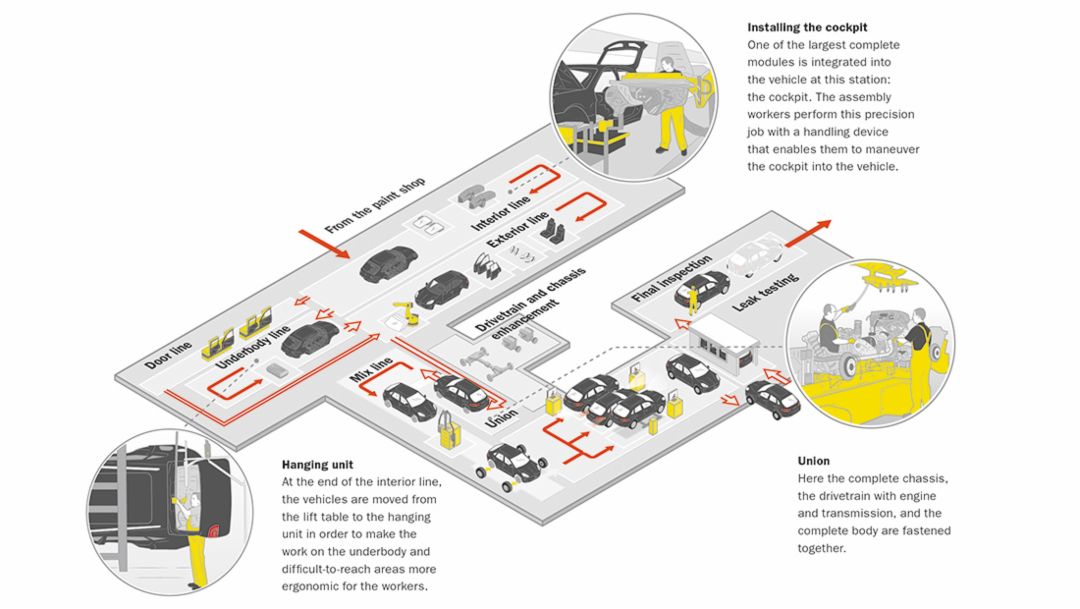Like every Porsche, the Macan epitomizes the optimal interaction of man and machine. The intelligently controlled production process involves multiple locations and many suppliers, and culminates in state-of-the-art production at the Leipzig plant. In our series "Made perfect – the journey of the Macan" we accompany the entire production process of the compact SUV. The third part takes a look behind the scenes of the assembly.
It’s the playful ease that first catches the observer’s eye. Bodies float by on overhead conveyor units or travel from one production area to another on lift tables in perfectly timed sequence. Electric tugger trains run back and forth supplying the assembly lines with material. It is a precisely coordinated harmony that seems to follow a higher order. Behind it all is the pearl necklace principle: a logistics process that functions without warehousing parts and in which the parts arrive at the assembly line “just in time, just in sequence” – that is, at just the right time and in the right order.
Some 1,500 employees were hired in the course of the plant expansion
But it’s not just the system – the employees exude this attitude as well. Some 1,500 employees were hired in the course of the plant expansion. All were individually qualified and integrated in the team. “Working for Porsche means approaching things with perfection and passion. Every single employee bears responsibility, but we achieve success only together,” says Oliver Blume. The board member is a team player. To understand all of the new work steps, during the transition period he joined the lines himself and worked on the production sequences.
In assembly, a whopping 225 stations await the Macan. It starts together with the Panamera on the door line. Here the doors are first finished before disappearing once again on the interior line. This simplifies the subsequent assembly steps, in which the doors would be in the way. The completely assembled cockpit, for example, is integrated with a special lifting device.
Before the underbody line, the body moves from the lift table to the overhead conveyor unit “to make work on the underbody more ergonomic,” as head of assembly Martin Kahmeyer explains. One principle of the Porsche production system: the process in which a part is installed only works as perfectly, simply, and quickly as possible if the employees have an easy job of it from an ergonomic standpoint.
Indispensable for the entire value chain is the quality assurance measures, as reflected in the zero-defect principle, among others: “Don’t accept defects, don’t make mistakes, don’t pass errors forward,” is the motto. One quality assurance measure introduced by Porsche is a special master jig, called a Meisterbock, for body and assembly parts. The precise fit of assembly add-on parts, for example, is tested by the inner Meisterbock. “With the joint wheel and these joint pins we check the measurements of the gaps,” explains production director Dirk Kolar as he places one of the pins in the joint between the rear light and rear valance. Perfect. “At regular intervals we invite the suppliers and show them where they have to be more precise.”
The Macan has left the underbody line with important parts such as the brake lines and the tank on-board. On the exterior line it not only gets its doors back but also receives its rear window and windshield – and the Porsche crest now decorates the hood. Now it heads to the mix line. It’s called the mix line because this is where the Cayenne comes in, bringing together the factory’s three models on a single line – a specialty of the Leipzig plant. By the way, the six-cylinder gas engines come from Stuttgart-Zuffenhausen. They’re delivered to the assembly supply center in Leipzig in trucks, and from there to the drivetrain enhancement line, which operates parallel to the body assembly.
The wedding happens fully automatically
While the body swings in on the overhead conveyor unit, the chassis and drivetrain approach their union on a driverless transport system. The special moment of joining happens fully automatically. The witnesses are the employees one station later, who screw the spring struts into the mounts. This step is followed by the filling with fuel, brake fluid, coolant, and motor oil. At the end of the mix line, the Macan is standing on its own four wheels. All that’s left now is the test facility, or finish.
Porsche added an extra line for the new SUV. This is where the software is uploaded, brakes tested, headlights set up, driver assistance systems calibrated, and – for the first time – the engine is started. Before it undertakes its journey to the customer, Porsche asks the Macan for one last dance. But this time, it is not for a round with the robots, but a whirl around the warm-up track. The Macan is ready for the world.
Consumption data
Macan: Combined fuel consumption: 9.2 – 6.1 l/100 km; CO₂ emission: 216 – 159 g/km
Cayenne (model year 2015): Combined fuel consumption: 11.5 – 6.6 l/100 km; CO₂ emission: 267 – 173 g/km
Cayenne S E-Hybrid: Combined fuel consumption: 3.4 l/100 km; CO₂ emission: 79 g/km; Electricity consumption: 20.8 kWh/100 km
Panamera: Combined fuel consumption: 10.7 – 8.4 l/100 km; CO₂ emission: 249 – 196 g/km
Panamera S E-Hybrid: Combined fuel consumption: 3.1 l/100 km; CO₂ emission: 71 g/km; Electricity consumption: 16.2 kWh/100 km

